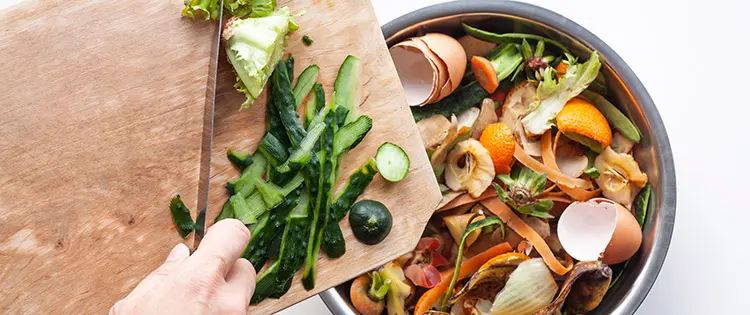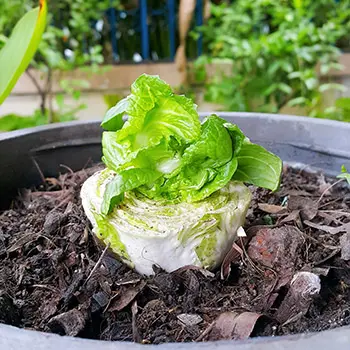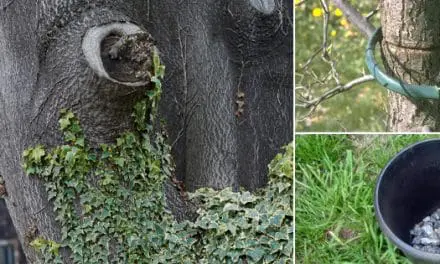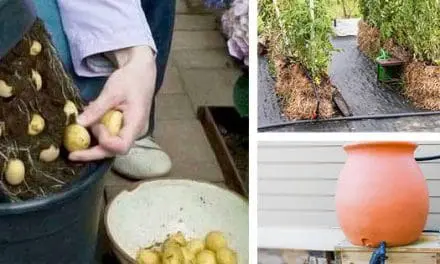You’ve chopped and sauteed and cooked everything down. There’s a pile of leftovers and you toss them in the trash. How dare you.
Tossing your kitchen scraps away is a terrible idea. While some may not be reusable (for instance, avocado rinds really aren’t good for much other than compost), the vast majority are. Let’s take a deep dive into what we can reuse and regrow from our kitchen scraps.
Outdoor Uses
Obviously, compost is a wonderful use of most kitchen scraps. Now, we can’t say all. After all, there’s not a lot of worth in the papery film from a clove of garlic. Sure, you can toss it in, but even if you use garlic by the pound you aren’t really getting anywhere with just the sheaths from the cloves. 
We’ve talked at length about compost, so it’s only getting a brief mention here today. Instead, I want to concentrate on what else you can do with your kitchen scraps.
One of my favorite things to do is to take old ham bones with tiny bits of meat and fat stuck to them (or beef bones, lamb bones, etc) out to the chickens. If you’re careful and make certain that other animals can’t access them, cooked bones are totally safe for chickens to peck, scratch, and polish off perfectly.
Better yet, they’ll increase the protein consumption and your yolks will be deeply orange. And, let’s be honest. Most of us are eating meat we’ve known from birth regardless if it came from our farm or someone else’s and we traded from it. Using every scrap that we can from that meat is the respectful thing to do.
Related: DIY Compost Tea
Most poultry can also have the tops of carrots, melons that are a little too ripe, peels from all fruits and vegetables other than onions and garlic, and they delight in it. We have a small bowl in our fridge that we add our peels and dump into their enclosure at bedtime every couple of days. They go absolutely crazy for it.
You may also consider re-planting with some of your scraps. Have a tiny clove of garlic that’s the last of the head? Go outside and plant it, or keep it for the planting season. Pull seeds from your fruits and vegetables to replant in your garden.
Plus, greens with root bases attached can be put in large pots filled with potting soil, watered, and will likely start growing within a few days if the outdoor conditions are right. You may also consider doing this inside if you have enough light.
Indoor Uses
As I mentioned, you can always regrow greens from intact root bases in a little bit of soil. Personally, I have a 9th-generation lettuce that I allow to go to seed every couple of years and then start growing again. I bought its great-great-grandcestor at a Walmart across the country over a decade ago. After about two years, the adult plant is pretty spent. So we just go ahead and let it reproduce and then I grow the next generation from it.
Another fun thing is to work with citrus and vinegar to clean the home. Did you make a fancy cocktail or a nice lemonade for the fridge and you’re stuck with peels or leftover fruit that you don’t have plans for? Put them in a quart mason jar full of vinegar for a few months and store it somewhere dark and cool (under a sink is perfect). You can also add herbs like rosemary and lavender for a little extra added scent to your new cleaning concoction.
When you’re ready to use your new cleaner, go ahead and strain out the fruits, herbs, and even spices if you’ve used some of those (star anise works great!). Put the vinegar back in the jar and mix it 1 to 5 ratio with water in a spray bottle.
Related: Can Vinegar Go Bad?
This cuts through grease easily and is a wonderful natural antibacterial cleaner that leaves your whole house smelling gorgeous. You can strengthen it if you need to all the way up to a 1 to 3 ratio, but I prefer a 1 to 5 ratio because it seems to be easier on my countertops.
You can also use your leftover peels and bits of spices left in mostly-used jars in a simmer. Simply put a pot on the stove full of water, tip your fragrant additions in, and let it simmer to give your home a fresh and tempting scent. Just be sure you watch it carefully.
Other Ideas for Using Kitchen Scraps
Raw egg shells and citrus peels can be used to sharpen and freshen garbage disposals simply by running them through the blades of the machine when it is functioning. Do be aware to do this in very small quantities because anything large will jam up most garbage disposals these days; though if you have an older model in which the machine is high horsepower, you may be in fine shape to pitch an entire basket in there and it’d just angrily blitz it all up.
You know your machine and I trust you with that knowledge, we just can’t be held liable if you end up needing a repair because you put too much down there too fast.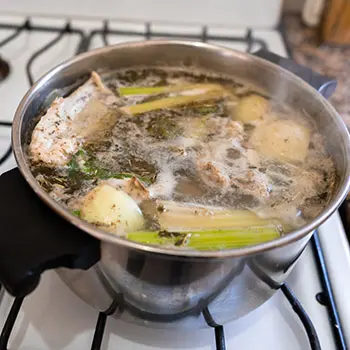
Last but not least, I usually save up chicken, pork, and beef bones to make bone broth for my livestock guardian dogs during the colder months. Most of my pack is getting older now (we’ll be starting a puppy soon, stay tuned for that!) and seem to appreciate the warm broth on their dinner each night before bed.
Related: 7 Foods You Can Cook From Scraps You Normally Throw Away
I put all the bones in a crock pot all day long covered with water and a capful of apple cider vinegar. I strain it through a very fine mesh or a cheesecloth and make certain the bones go straight into the trash afterward.
Then, I let the broth cool and portion it for freezing, with the livestock guardian dog team getting about 1/2 cup per 100 pounds of dog per day. Speak to your veterinarian about this before adding it to your pet’s food and, again, be certain those bones are never given to your dog. They can be deadly if they splinter. But the broth is safe and a wonderful treat for them.
What do you do with your kitchen scraps? Is there something particularly special that you think we missed? Be sure to tell us in the comments and, as always, Happy Homesteading.
Best Fuels For Off-Grid Survival
If You See This Plant in Your Backyard, Burn It Immediately! (Video)
Stop Throwing Away Your Lemon Peels. Do This Instead!

